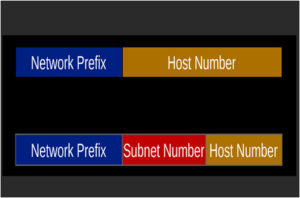
Date: 01/01/1986
Subnetting OperationSubnetting is the process of designating some high-order bits from the host part and grouping them with the network mask to form the subnet mask. This divides a network into smaller subnets. For IPv4, a network may also be characterized by its subnet mask, which is the bitmask that when applied by a bitwise AND operation to any IP address in the network, yields the routing prefix.
Subnetting enables the network administrator to further divide the host part of the address into two or more subnets. In this case, a part of the host address is reserved to identify the particular subnet. This is easier to see if we show the IP address in binary format. The subnet mask is the network address plus the bits reserved for identifying the subnetwork — by convention, the bits for the network address are all set to 1, though it would also work if the bits were set exactly as in the network address. In this case, therefore, the subnet mask would be 11111111.11111111.11110000.00000000. It’s called a mask because it can be used to identify the subnet to which an IP address belongs by performing a bitwise AND operation on the mask and the IP address.
Computers that belong to a subnet are addressed with a common, identical, most-significant bit-group in their IP address. This results in the logical division of an IP address into two fields, a network or routing prefix and the “rest” field or host identifier. The rest field is an identifier for a specific host or network interface. The routing prefix may be expressed in CIDR notation written as the first address of a network, followed by a slash character (/), and ending with the bit-length of the prefix. For example, 192.168.1.0/24 is the prefix of the Internet Protocol Version 4 network starting at the given address, having 24 bits allocated for the network prefix, and the remaining 8 bits reserved for host addressing. The IPv6 address specification 2001:db8::/32 is a large address block with 296 addresses, having a 32-bit routing prefix.
For IPv4, a network may also be characterized by its subnet mask, which is the bitmask that when applied by a bitwise AND operation to any IP address in the network, yields the routing prefix. Subnet masks are also expressed in dot-decimal notation like an address. For example, 255.255.255.0 is the network mask for the 192.168.1.0/24 prefix. Traffic is exchanged (routed) between subnetworks with special gateways (routers) when the routing prefixes of the source address and the destination address differ. A router constitutes the logical or physical boundary between the subnets. The benefits of subnetting an existing network vary with each deployment scenario. In the address allocation architecture of the Internet using Classless Inter-Domain Routing (CIDR) and in large organizations, it is necessary to allocate address space efficiently. It may also enhance routing efficiency, or have advantages in network management when subnetworks are administratively controlled by different entities in a larger organization. Subnets may be arranged logically in a hierarchical architecture, partitioning an organization’s network address space into a tree-like routing structure.